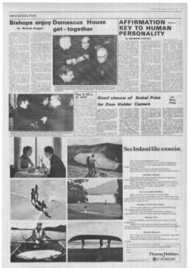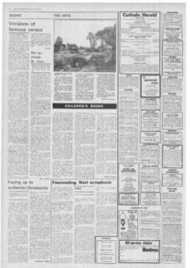Page 6, 25th January 1974
Page 6

Report an error
Noticed an error on this page?If you've noticed an error in this article please click here to report it.
Tags
Share
Related articles
Parents' Choice
Ardizzone Creator Of Little Tim
Parents' Choice
Enchantment
Graham Greene
CHILDREN'S BOOKS
The combination of Graham Greene's text and Edward Ardizzone's illustrations is irresistible in the two tales about Little Snoreing, The Little Train and The Little Fire Engine (both Bodley Head, f1.20), although the text is 30 years old and the pictures to go with it are quite recent. But it is hard to imagine Little Snoreing envisaged by anyone else, so beautifully does Mr. Ardizzone impress his style upon it.
Little Snoreing is a village so sleepy that even Much Snoreing, the nearby town, seems quite a metropolis by comparison, and the comings and goings of the little train are the big events of the day.
When the little train goes off to seek adventures he ends up at home again, in a circular. relieved sort of way, and when they try to replace the little fire engine with a more modern one, the old horse-drawn machine soon shows them that old things may still be best. These are books to keep and batter about in a family, full of the stuff that makes memories and myths.
Australia is an imaginative landscape as well as a geographical location, and many children who have grown up with some of the best Australian children's writers, live in it imaginatively in a curious, one-remove sort of way. For it is both like England and totally unlike it, is both tamiliar and completely new and strange. Patricia Wrightson is one of the best of a number of
Australian children's writers well known over here, and her anthology Beneath the Sun (Collins. £2.50) is a large, handsomely produced book with stories, poems, photographs, drawings and articles about this and that, all from Australia and giving a vivid picture of the Australian idiom, countryside and way of life.
A child already imaginatively involved with Australia would, I think, love to pore over it its accounts of settling days, goldmining days, picnics in the bush, survival under fierce conditions, Aboriginal stories; its lively tales of family life and the apparently inexhaustible energy of its people.
There is a whole vocabulary of Australian life which even the most ignorant must feel, in sonic imaginative way, has a special aura of its own, sunny and suggestive bunyip. damper, goanna. gumtree and so on. My own favourite from the whole book is Trooper O'Grady's Song which starts: "A bootfaced wife sat on the quay fishing like mad for kedgeree", with its delicious hoot-faced illustrations.
It is not, I think, very easy to transfer. small children, imaginatively, from their own culture fo one quite different From theirs, though wellmeaning efforts are often made to do it. In other words, it is not very easy for a small child to adapt
itself to unfamiliar surroundings in stories.
And. yet stories, especially at an early age, are one of the great linking influences in the world, and the fact that the same stories crop up over and over again, the same themes are repeated in every culture, does more than most things to suggest a common humanity, underlying links in time and space between all of us.
Jenny Seed's The Sly Green Lizard (Hamish Hamilton's Antelope Books, 60p) tells three stories from Africa, the first specifically from Zululand. All three involve some magic, and, nicely combined with it, a knowledge of human nature which suggests that magic may be just another way of putting quite explicable psychological St ates.
The telling is very attractive, sedate. exact and vivid. Africa is not Europeanised in the tales, but the non-African child can identify very cheerfully with the chiers spoilt daughter or the little girl left abandoned beside the river bank.
The Sly Green Lizard of the first story and the Lumpy Monster of the last have their equivalents in European folklore, and it must stretch a young mind to realise this, obscurely, by seeing familiar patterns in an unfamiliar setting.
Isabel Quigly
blog comments powered by Disqus









